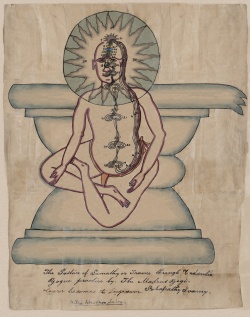Sabhapaty Swami: Difference between revisions
No edit summary |
No edit summary |
||
| Line 13: | Line 13: | ||
== Additional resources == | == Additional resources == | ||
* | * Cantú, Keith Edward. "Sri Sabhapati Swami: The Forgotten Yogi of Western Esotericism" ''The Occult Nineteenth Century''. Editors: Pokorny, Lukas, Winter, Franz. Springer, 2021. [https://www.springer.com/us/book/9783030553173?utm_campaign=sl-buybox_chapterPage_print&utm_medium=referral&utm_source=springerlink# Springer Link to preview and purchase chapter.] | ||
== Notes == | == Notes == | ||
Revision as of 14:45, 15 January 2021

Sabhapaty Swami was an Indian scholar from Madras who was acquainted with Theosophical Society Founders Helena Petrovna Blavatsky and Henry Steel Olcott. He was born in Madras in 1840. In 1880 he met the Founders in Lahore, and he moved back to Madras about the time the Adyar headquarters was established for the Theosophical Society. He published a number of scholarly works until the early 1890s, when he disappeared from the historical record. No death date has been determined.
Colonel Olcott owned a copy of his book Om: A Treatise on Vedantic Raj Yoga Philosophy that is still on the shelves of the Adyar Library and Research Centre. It is the original 1880 edition, and is very rare. In January, 2016, a group of librarians, photographers, archivists, and scholars from around the world worked together to get the book photographed. The original illustration was damaged, and has been digitally restored by Richard Dvořák. A searchable PDF file of the book has been cataloged as a digital object by the Henry S. Olcott Memorial Library and is also available here. Dr. Karl Baier of the University of Vienna wrote of the third handwritten line: "The (partially) missing word could originally have been sthūlaśarīra ('physical body,' sthūla meaning coarse) a Sanskrit word that especially in 19th century texts is sometimes written as sthulsarir."
Writings
- Vedantic raj yoga: ancient yoga of rishies. Lahore, 1880. New Delhi: Pankaj Publications, 1977. 62 pages with illustrations. The 1977 edition has limited availability at Google Books and Hathitrust. "A historical view of the theories of the soul" by Alexander Bain: p. [46]-62. Reprint of the 1880 ed. published in Lahore." The author is given as Mahahtma Giana Guroo Yogi Sabhapaty Swami.
- Esoteric cosmic yogi science, or, Works of the world teacher. 1888. Excelsior Springs, Mo.: Super Mind Science Publications, 1929. Two volumes. "This book consists of teachings written down by disciples of the great master, Guru Yogi, Sabhapathi Swami, gnyana yogi of India ... These manuscripts were published in India in part ... in the year of 1888 ... the author-publisher now offers them to the English speaking western world students of yoga."--Forward. A digital version of the Volume I 1923 edition can be purchased at Google Books.
- The philosophy and science of Vedanta and Raja Yoga. Bombay, C.P. Mandali, 1950. 81 pages with illustrations. Edited by Srisa Chandra Vasu. Author given as Mahatma Jnana Guru Yogi Sabhapathy Swami.
- Rajayoga Brahmajñananubhuti sangraha veda namaka grantha. Mumbai: Tattvavivecaka Chapakhanemem Chape, 1892. Sanskrit text with Hindi explanation. 134 pages with illustrations.
Additional resources
- Cantú, Keith Edward. "Sri Sabhapati Swami: The Forgotten Yogi of Western Esotericism" The Occult Nineteenth Century. Editors: Pokorny, Lukas, Winter, Franz. Springer, 2021. Springer Link to preview and purchase chapter.